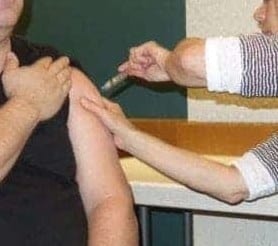Cases of the flu have increased substantially in Yellowknife from this time one year ago partly due to an outbreak of a flu strand not covered in this year's vaccine and an early peak for the virus overall.
Influenza H3N2, a variation of influenza A, helped push the number of flu cases overall the first week of January to 71 from around nine at the same time in 2017.
Chief Public Health Officer Dr. Andre Corriveau said the peak of flu season in 2017 was mid-January, with the peak this year apparently happening mid-December.
Corriveau said the real number of flu cases can be elusive.
"A lot of people aren't sick enough to be diagnosed," said Corriveau. "Some people who are sick will still go to work."
The GNWT provided several free vaccination clinics in the fall, with vaccines distributed containing three types of influenza vaccine.
Media reports from 2016 indicated a similar situation where the GNWT offered people protection against certain types of influenza, but H3N2 wasn't guarded against.
"Although there indeed appears to be some degree of vaccine mismatch against the dominant A:H3N2 strain this year, the vaccine does offer valuable protection, not only against other strains of the virus but also against more severe complications," said Manager of Communications for health and social services, Damien Healey.
A respiratory syncytial virus (RSV) or 'common cold' virus is also present.
RSV attacks the respiratory system and can be life-threatening for any child under the age of two, said Corriveau.
"If a child is exposed to the disease it can become overwhelmed with congestion" said Corriveau, noting there have been three cases of RSV.
Severe cases of RSV can cause pneumonia or bronchiolitis in infants.
Some of the severe side-effects associated with RSV – such as wheezing, bluish skin and a severe cough – means children should see a doctor immediately, according to mayoclinic.org.
Corriveau said measures that can be taken to avoid catching or spreading RSV are similar to those used to stop the flu: wash your hands, cough into your sleeve; and have hand sanitizer available. He added there is a program at Stanton Territorial Hospital which can protect premature babies from contracting the virus.
The most common way to contract the flu is by exposure to someone who already has it.
For that reason, Corriveau has recommended avoiding people who have the flu, staying home from work or school if you have it and wash your hands often – especially after blowing your nose, sneezing or coughing.
Some people such as Yellowknifer Lisa Vanterve believe travelling in and out of the city by air during the holidays only made the possibility of catching the flu worse.
"I flew to Edmonton on Dec. 20 and came back to Yellowknife on Dec. 24 sick as all out," said Vanterve.
"Flying does that, it's inevitable."
This winter five people have been hospitalized for the flu but there have been no confirmed deaths.
"We have issued some reminders but I haven't heard any overwhelming demand on health care," said Corriveau.
The Northwest Territories Health and Social Services Authority didn't have flu-shot numbers available for this year, but it is estimated 20 per cent of the population receive flu shots annually.
In October, the NWT – with the exception of the Sahtu and Beaufort Delta – was flagged by the Public Health Agency of Canada as one of several regions around the country as already experiencing sporadic cases of influenza in early and mid-September.
